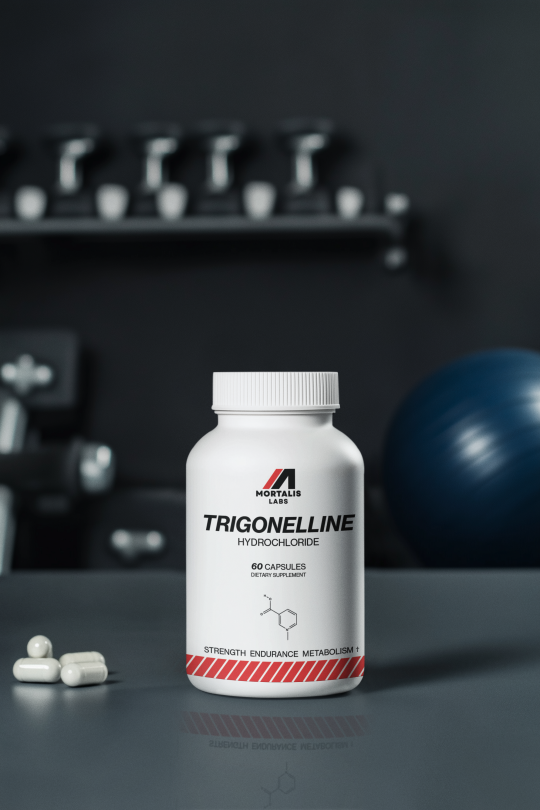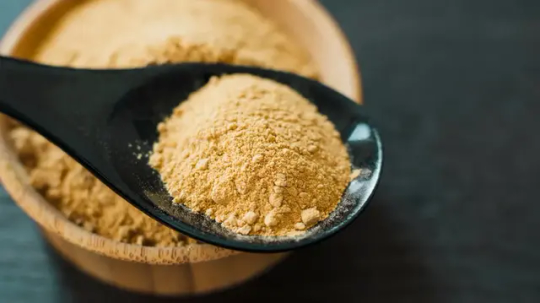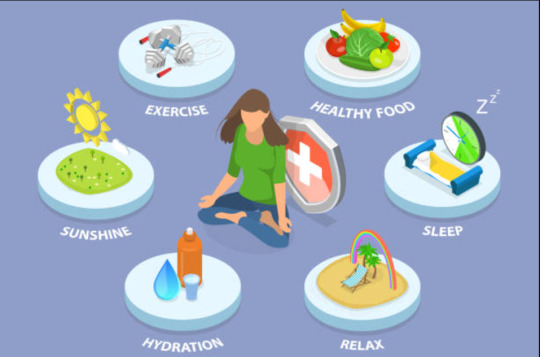#HealthTips"
Explore tagged Tumblr posts
Text


Trigonelline is a methylated form of niacin and is a recently isolated molecule that could be the secret ingredient in your stack. This form of the B vitamin is involved in the generation of NAD+, a cofactor for over 500 metabolic processes in cells. Trigonelline promotes cellular repair and energy, and as we’ll see, exerts quite a few benefits that are specifically useful for anyone training seriously.
Trigonelline is found in several plant-based foods, notably coffee beans and fenugreek seeds. Green coffee beans contain trigonelline concentrations ranging from 0.6% to 1.0% by weight. However, traditional dietary sources don’t provide sufficient amounts to elicit significant physiological effects. For instance, the average trigonelline content in a cup of coffee is approximately 53 mg, and about 50-80% of trigonelline decomposes during the roasting process, leaving virtually nothing for your body to make use of.
Recent research published on this naturally occurring alkaloid highlights its potential in enhancing muscle function and combating age-related decline. A 2024 study published in Nature Metabolism identified trigonelline as a novel precursor to nicotinamide adenine dinucleotide (NAD+), a molecule essential for energy metabolism and mitochondrial function. The study demonstrated that trigonelline supplementation improved muscle strength and reduced fatigue in aged mice, suggesting that it can head off the natural muscle decline seen in aging, even in those who are already training at capacity.
NAD+ gets discussed a lot in the longevity space because of its natural and steep decline over the years, tied to all the diseases of aging. It's a metabolic linchpin that determines how efficiently your cells convert fuel into usable energy. For athletes, that efficiency translates into faster recovery, better performance under load, and greater resilience under metabolic stress. Or, you know, complete lack of those things if you don’t have enough of it.
NAD+ is required for redox (oxidation–reduction) reactions in mitochondrial energy production and is a cofactor and substrate for longevity-promoting sirtuins and other enzymes involved in muscle repair and adaptation. During intense physical activity, NAD+ levels drop as demand for ATP surges. Replenishing intracellular NAD+ is critical not only for restoring mitochondrial output but also for initiating the cellular programs that rebuild and reinforce muscle tissue [1].
Trigonelline offers a direct path to NAD+—one that bypasses the liver and supports muscle tissue specifically. In a landmark 2024 study, researchers at EPFL and Nestlé Health Sciences (yes, that Nestlé, but there aren’t any conflicts of interest, we checked) demonstrated that trigonelline functions as a previously unidentified NAD+ precursor, rapidly taken up by skeletal muscle cells and converted into NAD+ via a salvage pathway independent of the traditional NR or NMN routes [2]. This muscle-specific uptake is particularly important for athletes, who require localized replenishment in the very tissues under stress.
Most NAD+ precursors—including nicotinamide riboside (NR) and nicotinamide mononucleotide (NMN)—undergo hepatic metabolism before entering systemic circulation. This creates a bottleneck at your liver for targeted muscle repair. Trigonelline appears to bypass that constraint by delivering precursors directly where they're needed most: the muscle fibers responsible for performance and endurance.
This shift in delivery has implications beyond simple NAD+ restoration. In the same Nature Metabolism study, aged mice supplemented with trigonelline showed significant improvements in grip strength and fatigue resistance—outcomes tightly linked to muscle NAD+ availability. Unlike systemic precursors that may elevate circulating NAD+ levels without improving localized bioenergetics, trigonelline drives changes in muscle mitochondrial density and function.
For athletes, this is the difference between feeling recovered and actually being rebuilt.
Mitochondria Make Muscles Move
Endurance Starts in the Electron Transport Chain
Every sprint, every lift, every set depends on one thing: mitochondrial output. The ability to generate ATP on demand—efficiently and cleanly—is the defining line between sustained power and early fatigue. Trigonelline’s value lies not just in elevating NAD+ levels, but in what that elevation enables at the level of mitochondrial performance.
NAD+ drives oxidative phosphorylation, the mitochondrial pathway responsible for converting nutrients into ATP. When NAD+ is depleted, electron transport slows, reactive oxygen species accumulate, and mitochondrial output tanks—resulting in performance collapse and prolonged recovery. Replenishing NAD+ restores mitochondrial throughput, enhances metabolic flexibility, and allows cells to switch between carbohydrate and fat oxidation with minimal friction [3].
Trigonelline’s role as a direct NAD+ precursor in muscle tissue makes it especially powerful in this context. By bypassing hepatic metabolism and restoring NAD+ where it's most needed, it kickstarts mitochondrial biogenesis—activating pathways like PGC-1α that drive the formation of new mitochondria and increase the efficiency of existing ones [4]. This isn’t theoretical: in the 2024 Nature Metabolism study, trigonelline supplementation significantly boosted mitochondrial content and activity in aged mice, restoring performance metrics typically lost with age and overtraining [2].
This cellular shift translates directly to the field, the track, and the gym. More mitochondria means more ATP per unit of oxygen consumed. This is the underpinning of higher VO₂ max, improved lactate clearance, and extended time-to-exhaustion. Trigonelline supports this adaptation at the source, which means athletes can train harder, go longer, and bounce back faster—without relying on stimulants or sketchy ergogenics.
More NAD+ in muscle equals better mitochondrial kinetics, which equals better athletic output. Period.
Strength and Muscle Health
Preserving Power, Not Just Mass
Strength isn’t only about size—it’s about contractile quality, neuromuscular precision, and the cellular capacity to resist breakdown under stress. Trigonelline’s impact on muscle tissue reaches beyond endurance. It supports structural integrity, performance output, and resilience across multiple pathways—especially in the context of aging or chronic training demand.
In the 2024 Nature Metabolism study, trigonelline supplementation restored muscle grip strength and improved fatigue resistance in aged mice, with outcomes exceeding those observed in control groups receiving traditional NAD+ precursors [2]. This effect was tied to increased NAD+ availability in skeletal muscle, which reactivated SIRT1- and PGC-1α-dependent pathways responsible for mitochondrial biogenesis, inflammation control, and protein maintenance—all critical for contractile performance and mass preservation [5].
NAD+ also plays a protective role against muscle wasting. It regulates the balance between anabolic and catabolic signaling, modulating FoxO transcription factors and suppressing atrophy-related genes like MuRF1 and atrogin-1 [6]. This anti-catabolic signaling becomes especially important during periods of calorie deficit, illness, or overreaching, when muscle degradation accelerates. Trigonelline, by supplying NAD+ directly to muscle cells, may help maintain lean mass even under systemic stress.
One overlooked aspect of muscle performance is neuromuscular junction (NMJ) stability, or, the connections between nerves and muscle fibers. These connections go both ways, with afferent signals carrying sensory feedback from muscle to brain, and efferent signals delivering motor commands from brain to muscle. Maintaining the integrity of this bidirectional communication is essential for coordination, strength, and rapid recovery from fatigue. NAD+ is required for the function of enzymes that protect NMJ architecture—particularly in aging or disease models where synaptic decline contributes to strength loss [7]. Trigonelline’s direct muscle delivery may therefore preserve the electrical signaling fidelity needed for explosive power and motor unit recruitment.
Muscle Fiber Type Preservation
Emerging evidence suggests that NAD+ availability influences muscle fiber type composition. High NAD+ levels favor the maintenance of fast-twitch (Type II) fibers—those responsible for strength, speed, and power—by enhancing mitochondrial support without triggering full transition to slow-twitch oxidative profiles [8]. This has implications for athletes seeking to maintain peak force output without compromising endurance. By elevating muscle NAD+ directly, trigonelline may help preserve this delicate fiber balance.
Trigonelline is formulated not to just support general energy—but to protect the architecture of athleticism at the cellular level.
For a reliable, pure form of trigonelline with zero additives, you can trust Mortalis Labs.
#longevity#trigonelline#nmn#fitness#gym#metabolismboost#metabolismsupport#healthylifestyle#healthtips#healthy living
506 notes
·
View notes
Text
💧 Drinking Water WRONG?! 🤯 5 Hydration Myths You Need to Stop Believing RN!
Hydration feels simple, right? Just drink water! But between the "8 glasses a day" rule and warnings about coffee, the advice can get seriously confusing. 😵💫
Are you accidentally sabotaging your hydration game based on outdated myths? Let's bust 5 common ones right now:
Myth #1: You MUST drink exactly 8 glasses (64 oz) of water per day.
BUSTED! 💥 Reality: This is a generic guideline, NOT a universal rule. Your actual water needs depend heavily on factors like your activity level, climate, body size, health status, and diet. Someone working out in the heat needs way more than someone sedentary in a cool office.
Instead: Listen to your body's thirst signals and pay attention to your urine color (aim for pale yellow).
Myth #2: If you feel thirsty, you're already dangerously dehydrated.
BUSTED! 💥 Reality: Thirst is your body's normal and healthy signal that it's time to drink fluids. It doesn't automatically mean you've hit a critical dehydration danger zone. It's simply a cue to rehydrate soon.
Instead: Sip water consistently throughout the day, and definitely drink when you feel thirsty. Don't panic!
Myth #3: Only plain water counts towards your daily hydration.
BUSTED! 💥 Reality: ALL fluids contribute to hydration, along with water-rich foods! Think milk, juice, herbal teas, soups, and even fruits and vegetables (like watermelon, cucumber, oranges). They all add water to your system.
Instead: Enjoy a variety of hydrating fluids and foods. Water is often the best choice (no calories/sugar), but it's not the only choice.
Myth #4: Coffee and tea are dehydrating because they contain caffeine.
BUSTED! 💥 Reality: While caffeine is a mild diuretic (makes you pee a bit more), the water content in coffee and tea far outweighs this effect. They still contribute a net positive amount of fluid to your daily intake.
Instead: Enjoy your coffee or tea in moderation as part of your overall fluid consumption. Just don't rely on highly caffeinated drinks as your sole source of hydration.
Myth #5: Your urine needs to be completely clear to be properly hydrated.
BUSTED! 💥 Reality: Aiming for consistently clear urine might actually mean you're over-hydrating, which can dilute electrolytes. The ideal color is typically a pale, straw-like yellow. Dark yellow usually means drink more; totally clear might mean ease up slightly.
Instead: Use urine color as a general guide, aiming for pale yellow, but don't obsess over achieving crystal clear pee all day long.
The takeaway? Hydration is more nuanced than rigid rules suggest. Focus on listening to your body, sipping fluids consistently, and enjoying water-rich foods. Stay hydrated, stay healthy! ✨
#hydration#water#healthmyths#mythbusting#wellness#healthtips#nutrition#healthyhabits#drinkwater#wellbeing#fitness#healthylifestyle#selfcare#didyouknow#sciencefacts#stayhydrated#coffeemyths#teatime#tumblrhealth
7 notes
·
View notes
Text

Maca root is a cruciferous vegetable native to the Andes mountains of Peru that is used in supplements and dietary supplements:
What it isMaca root, also known as Lepidium meyenii or "Peruvian ginseng", is the root of a vegetable that is related to broccoli, cauliflower, cabbage, and kale.
BenefitsSome say maca root can help with sexual function, libido, energy, fertility, and erectile dysfunction. Others say it may help with mood, anxiety, blood pressure, and sun damage.
HistoryIndigenous people of the Andes have used maca root for centuries as a food source and traditional remedy.
IngredientsMaca root contains fiber, vitamins, minerals, and bioactive compounds like macamides, macaridine, alkaloids, and glucosinolates.
ProductsMaca root is available in supplements and dietary supplements, such as capsules and powders.
ResearchThere is not enough human-based research to fully support the uses of maca root

Maca root, a cruciferous vegetable native to Peru, has been traditionally used for its various health benefits. Here are some of the potential benefits of maca root:
Sexual Health:
May improve libido and sexual desire in both men and women.
May enhance fertility and sperm quality in men.
May alleviate menopausal symptoms such as hot flashes and night sweats.
Hormonal Balance:
May help regulate hormone levels and improve hormonal balance, especially in women.
May reduce symptoms of premenstrual syndrome (PMS).
Bone Health:
May increase bone mineral density and reduce the risk of osteoporosis.
Energy and Endurance:
May provide a boost in energy levels and improve athletic performance.
May help reduce fatigue and stress.
Mood and Cognitive Function:
May improve mood and reduce symptoms of depression and anxiety.
May enhance cognitive function and memory.
Other Potential Benefits: May have antioxidant and anti-inflammatory properties, May protect against cardiovascular disease, and May improve gastrointestinal health.
Note: It's important to note that most of these benefits are based on limited scientific evidence. More research is needed to confirm these effects. Additionally, consult with a healthcare professional before consuming maca root, especially if you have any underlying medical conditions or are taking any medications.
#kemetic dreams#maca root#fitness#health and wellness#health & fitness#health and fitness#health is wealth#healthblr#healthcare#healthtips#healthier#healthy#health journey#health benefits#health#healthy habits#healthy food#healthy life#healthy eating#healthy living#healthy snack#healthyhabits#healthyeating#healthylife#healthy lifestyle#healthy diet#healthylifestyle#healthyliving#heart health#mental health
13 notes
·
View notes
Text
जामुन खाने के फायदे 💯 .
health #fitness #reelitfeelit
#viral video#viral#healthyfood#viral trends#health#fitness#fyp#healthtips#adult human female#fitnessmodel
3 notes
·
View notes
Text
Throwback to a time when I used to reach for food to deal with stress—using it as comfort when things felt overwhelming. I was carrying an extra 60 lbs and didn’t realize how much my habits were weighing me down, physically and emotionally.
Fast forward to today, and now the gym is my go-to stress release. Now, in the middle of perimenopause, I’ve found that hitting the gym and fueling my body with the right nutrition are more important than ever. Moving my body, pushing through those tough workouts, and focusing on my strength has transformed my life.
But it’s not just about the workouts—fueling my body with the right nutrition gives me the energy to show up for myself, my family, and my clients every day, both in the gym and in life.
We all have our challenges—this is how I’m navigating mine. How are you showing up for you? 💪🏽🥗
#fitness#health#healthy#workout#exercise#womenshealth#perimenopause#weightloss#health journey#fitness motivation#fitnessjourney#Food#nutrition#diet#lifestyle#healthylifestyle#healthyliving#healthtips#motivation#inspiration#fitnessmotivation
10 notes
·
View notes
Text
Best Natural Home Remedies for Kids’ Coughs & Colds
Why Home Remedies Matter for Kids
As parents, watching our children battle a fever, cough, or upset stomach can feel overwhelming. While modern medicine has its place, many pediatricians agree that simple, natural remedies often provide safe and effective relief—without the side effects of over-the-counter medications. In fact, the American Academy of Pediatrics (AAP) cautions against using cough syrups for children under 6 and emphasizes hydration, rest, and honey (for kids over 1) as frontline treatments.
#NaturalRemedies#KidsHealth#CoughRelief#ColdRemedies#ParentingTips#HomeRemedies#ChildCare#HealthTips#FluSeason#WellnessForKids
3 notes
·
View notes
Text

🛡️ Boost your immunity naturally! Small steps = strong defense 💪
✅ Eat fruits & veggies 😴 Sleep 7–8 hours 🏃♀️ Exercise daily 💧 Stay hydrated 🌞 Get sunlight (Vitamin D)
Your immune system deserves daily care. Follow @MyHospitalNow for more wellness tips! 🌿
3 notes
·
View notes
Text
"10-Minute Morning Stretch to Kickstart Your Day"
Feeling stiff in the morning? This quick stretch routine will wake up your body and get you ready to tackle the day! Whether you're rushing to work or starting a relaxing weekend, these stretches are perfect for everyone.
Mornings can be tough, but starting with a quick stretch can make all the difference. Here's a simple, 10-minute routine that targets key muscle groups, helping you feel energized and ready to take on whatever the day brings.
1. Neck Rolls (1 minute)
Slowly roll your neck in a circle, first clockwise and then counterclockwise, to release tension.

2. Shoulder Shrugs (1 minute)
Lift your shoulders up to your ears and then roll them back down, easing tightness in your shoulders and upper back.

3. Cat-Cow Stretch (2 minutes)
Get on all fours and alternate between arching your back (cow) and rounding it (cat) to stretch your spine.

4. Downward Dog (2 minutes)
From the cat-cow position, push up into downward dog, stretching your hamstrings and calves.

5. Forward Bend (1 minute)
Stand up and slowly bend forward, reaching for your toes to stretch your back and legs.

6. Standing Quad Stretch (2 minutes)
Stand on one leg, grab your opposite ankle, and pull it towards your butt to stretch your quads. Switch legs after one minute.

7. Side Stretch (1 minute)
Stand with your feet shoulder-width apart, raise one arm overhead, and lean to the opposite side to stretch your obliques.

"What’s your go-to morning stretch? Share it in the comments, and let’s inspire each other to start the day right!"
#morning routine#stretching#fitness#wellness#healthtips#mens health#home workout#do your homework#health hacks#workout
9 notes
·
View notes
Text

2 notes
·
View notes
Text
खजूर खाने के फायदे
youtube
#disease#healthyfood#healthtips#healthy#healthcare#health#viralshort#ytshorts#youtubeshorts#onion#olive#pachantantr#improvedigestion#digestivesystem#cancer#sugar#asthma#trend#trendindshorts#facts#like#motivation#drnehamishra#hairfall#Amla#IndianGooseberry#Ayurveda#Superfood#HealthyLiving#Wellness
2 notes
·
View notes
Text
youtube
🎥 Why Are Piles Becoming So Common in Young People?
In this eye-opening video, Dr. Parvesh Jain explains why more people in their 30s are now experiencing piles—something that used to mostly affect those over 50.
😟 Many young adults feel embarrassed and avoid seeing a doctor, turning to over-the-counter meds instead. But self-medicating can lead to serious complications.
💡 If you're struggling with piles, don't delay or stay silent. Early treatment can make a huge difference.
👨⚕️ Get expert care at Jain Multispeciality Hospital, Khanna—where your health and dignity come first.
📲 Watch, learn, and share this important message to break the stigma and spread awareness.
#PilesAwareness#HealthTips#DigestiveHealth#MensHealth#WomensHealth#Hemorrhoids#BreakTheStigma#DoctorAdvice#PublicHealth#YoungAdultsHealth#Youtube
2 notes
·
View notes
Text
Simple Tip for Gut & Skin: Stay Hydrated!💧

Drinking enough water supports your digestion AND helps keep your skin looking plump and radiant! ✨ Aim for pure water throughout the day for that healthy glow! 🌿😊
#hydration#guttip#skintip#wellness#healthtips#naturaradiance#digestivehealth#beautytips#selfcare#beauty#healthyskin#skincare#health and wellness
2 notes
·
View notes
Text
🤔 Reading Labels Like a Detective: 5 Ingredients Secretly Sabotaging Your Food Choices! 🕵️♀️
You're trying your best! You grab the yogurt labeled "low fat," the "whole grain" bread, the "natural" granola bar... thinking you're making great choices for your well-being. But sometimes, the front of the package tells a very different story than the ingredient list hidden on the back. 😵💫
Food companies are masters at marketing, often using health buzzwords while sneaking in ingredients that might not align with your wellness goals (often for better taste, texture, or shelf life). Becoming a savvy label reader is your superpower!
Watch out for these 5 common culprits lurking in unexpected places:
Added Sugars (Under Many Disguises):
The Issue: Beyond just "sugar," look for high fructose corn syrup, dextrose, maltodextrin, evaporated cane juice, agave nectar, etc. Excess added sugar impacts blood sugar, energy levels, inflammation, and offers empty calories.
Hides In: Flavored yogurts, granola/protein bars, cereals, pasta sauces, salad dressings, ketchup, plant-based milks, canned fruit.
Refined Vegetable & Seed Oils:
The Issue: Highly processed oils like soybean, corn, canola (rapeseed), sunflower, and safflower oil are prevalent. They can be high in omega-6 fatty acids, which, in excess relative to omega-3s, may contribute to inflammation for some.
Hides In: Many salad dressings (even "healthy" ones!), baked goods, crackers, chips, granola, vegan mayos, some nut butters.
Artificial Sweeteners:
The Issue: Sucralose, aspartame, acesulfame potassium (Ace-K), etc., are used in "sugar-free" or "diet" products. While calorie-free, research is ongoing about their long-term effects on gut health and potential impact on cravings.
Hides In: Diet sodas, "light" yogurts, sugar-free candies/gum, protein powders, flavored water enhancers.
Excess Sodium:
The Issue: Beyond just salty taste, high sodium levels can contribute to high blood pressure and water retention. It's often used generously as a preservative and flavor enhancer.
Hides In: Canned soups/vegetables, cottage cheese, processed deli meats (even turkey/chicken!), bread, frozen meals, sauces, savory snacks.
Gums, Thickeners & Emulsifiers:
The Issue: Ingredients like carrageenan, xanthan gum, guar gum, soy lecithin help create desirable textures, especially in low-fat or dairy-free products. Some individuals find they can cause digestive upset or inflammation.
Hides In: Non-dairy milks (almond, oat, soy), low-fat yogurts, ice creams, salad dressings, gluten-free products, processed cheeses.
Your Action Plan: Become an Ingredient Detective! 🕵️
Ignore Front-of-Package Hype: Look past flashy claims like "natural," "low-fat," or "whole grain."
Flip it Over: The ingredient list is where the truth lies. Ingredients are listed by weight, from most to least.
Shorter is Often Better: Generally, fewer ingredients, especially ones you recognize as whole foods, is a good sign.
Question Everything: If you don't recognize an ingredient, look it up!
#foodlabels#readthelabel#hiddeningredients#healthyeating#cleaneating#nutrition#wellness#foodawareness#processedfood#sugar#healthtips#wholefoods#ingredientsmatter#eatrealfood#marketingmyths#tumblrhealth
3 notes
·
View notes
Text
First Time Seeing a Gastro Physician? Ask These Key Questions!

Your gut health matters—and your first appointment with a Gastro Physician is the perfect time to get clarity. 🤔 Be prepared with smart questions like:
✔️ What could be causing my symptoms? ✔️ Do I need any tests? ✔️ Are my symptoms diet-related? ✔️ What are my treatment options? ✔️ Should I see a dietitian too?
Asking the right questions helps you take charge of your digestive health from Day 1.
2 notes
·
View notes
Text
मूली के जूस पीने के फायदे 💯 .
health #healthy #healthylifestyle
#viral video#viral#healthyfood#viral trends#health#fyp#fitness#healthtips#adult human female#fitnessmodel
4 notes
·
View notes
Text

#brain#brainhealth#mentalhealth#walk#Walking#exercise#Fitness#movement#Health#healthylifestyle#healthtips
59 notes
·
View notes